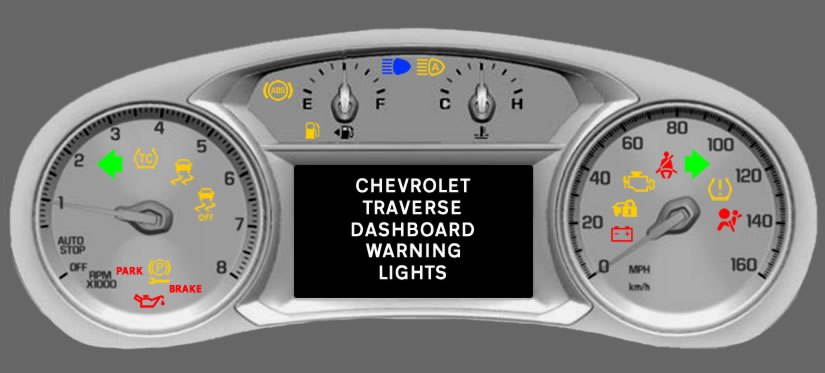Chevrolet Traverse Dashboard Warning Lights
The Chevrolet Traverse is a mid-sized SUV that’s been in production since 2009. These warning lights aim to explain what each symbol means and to provide advice on what to do based on Chevrolet’s recommendation.
The Chevrolet Traverse’s dashboard display design and warning light location may vary depending on your model. In general, red warning light should require immediate attention as may indicate a risk to vehicle occupancy safety.
 Airbag Warning Light
Airbag Warning Light
The Chevrolet Traverse airbag warning light comes on for several seconds as a system check once the vehicle is started. If it fails to come on or remains constantly lit, it means there’s a fault with the system. The airbag warning light can come on for several reasons including:
- Faulty or damaged sensors
- Low battery charge
- Dislodged wiring – often under the front passenger seat
- Seatbelt sensors
- Airbag clock spring
 Battery Charge Warning Light
Battery Charge Warning Light
As with most other warning lights, if the Chevrolet Traverse battery warning light remains lit after the engine has started, it means there’s a fault with the charging system. If you have not yet driven the vehicle and only started the engine, do not drive as there’s a possibility that the engine may shut down once the battery charge is depleted.
If you’re driving when the battery warning light comes on, turn off any equipment that’s not needed to save battery charge, then make your way immediately to the nearest vehicle repair workshop. Common reasons for the battery light to come on include:
- Ageing battery
- Battery wiring / connections are loose or corroded
- Voltage regulator
- Faulty alternator
- Drive belts
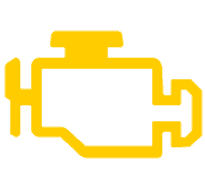 Engine Malfunction Warning Light
Engine Malfunction Warning Light
The Chevrolet Traverse engine malfunction warning should come on to show that the light is working when the ignition is in service mode. The light should go out shortly after. If the engine malfunction light remains lit, it means there’s a fault with the emissions control system.
The Chevrolet Traverse’s onboard diagnostics system detects faults and alerts the driver that there’s a problem by illumination of the engine malfunction fault. The engine malfunction warning light can come on for various reasons and because of this, diagnostic scanners are required to locate the fault.
When the engine malfunction warning light comes on, a fault code is generated and stored. Diagnostic scanners read the fault codes and help you locate the problem. Diagnostic scanners can be purchased online, or you take take you Traverse to vehicle workshop to use their equipment.
You can usually continue to drive with the engine fault light on, but continued driving over time may cause damage. However, if the engine light is flashing, reduce speed and avoid hard acceleration. If the light continues to flash, have your Traverse serviced right away to prevent further damage. Common reasons for the engine warning light can include:
- Bad oxygen sensor – measure the quantity of air leaving the exhaust system.
- Bad mass airflow sensor – measure the quantity of air entering the engine.
- Bad exhaust gas recirculation valve (EGR) – controls the flow of exhaust gas being recirculated.
- Particulate filter – usually on diesel engines, but becoming more popular on gasoline engine, the particulate filter captures soot and can become blocked.
- Catalytic converter – cleans up the exhaust emissions.
- Fuel injectors – these inject fuel into the engine and can become blocked.
- Poor fuel quality.
- Gas cap is not closed.
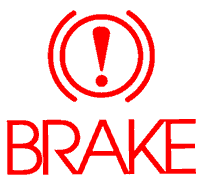 Brake Warning Light
Brake Warning Light
Along with many of the other warning lights that illuminate with the ignition switched to ‘on’, the Chevrolet Traverse brake warning light should illuminate, then go off soon after. If the red brake light fails to illuminate, have it fixed so that it can warn of any brake issues.
Depending on your model of Traverse, the brake warning light may display as a red exclamation point symbol or display as textual form. If the brake warning light remains constantly lit, it indicates:
- Low brake fluid – if driving, stop as soon as safely possible and check brake fluid levels. Use only GM approved DOT 3 brake fluid from a clean, sealed container. Worn brake pads can reduce brake fluid levels. If fluid level reduces often, it may be an indicator of a leak. In this instance, the brake pedal may feel spongy and can be pressed further than usual.
- Brake booster fault – brake booster is a system that amplifies pressure enabling assistance to the driver when pressing the brake pedal. In this instance, the pedal may feel much firmer to press than usual.
- Brake system fault – A fault in the vehicle’s brake system.
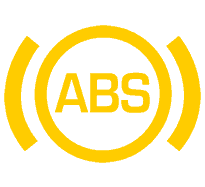 ABS Warning Light
ABS Warning Light
ABS (Anti-lock Braking System) is a function that prevents the wheels from locking during heavy braking, therefore enabling the driver to steer the vehicle. If the ABS light remains constantly on, it means ABS has malfunctioned, but normal vehicle brakes continue to operate as normal.
The most common cause for the Chevrolet Traverse ABS warning light to come on is due to a faulty wheel speed sensor. If the ABS and brake warning light both come on, it means there’s a fault with the vehicle’s brake system.
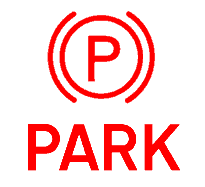 Parking Brake Warning Light
Parking Brake Warning Light
This symbol illuminates when the parking brake is applied. If the red symbol flashes after the parking has been released, it means there’s a fault with the electric parking brake. Electric parking brake faults are usually electrical related, but can also be caused by low battery voltage or the parking brake switch or motor. Ideally a capable scan tool should be used to read fault / trouble codes.
Alternatively to the flashing parking brake light the electronic parking brake system and wrench warning light may illuminate ![]() indicating that the electronic parking brake requires a service.
indicating that the electronic parking brake requires a service.
 Tow/Haul Mode Warning Light
Tow/Haul Mode Warning Light
The Chevrolet Traverse tow/haul mode assists in maintaining desired vehicle speeds when driving on downhill grades by using the engine and transmission to slow the vehicle. This helps to prevent the vehicle’s brakes from overheating.
The Chevrolet Traverse is front-wheel drive or two-wheel drive when the engine is started. When the tow/haul mode is switched on via the dashboard button, AWD is activated. The transmission holds lower gears longer before shifting to provide more torque necessary when towing heavy loads. This will also increase fuel consumption. Tow/haul mode is deactivated each time the engine is started.
 Lane Keep Assist Warning Light
Lane Keep Assist Warning Light
The Chevrolet Traverse Lane Keep Assist (LKA) system uses a camera sensor located at the top of the windshield to monitor the vehicle’s road position. If the system determine that the vehicle is exiting a lane unintentionally, the warning light flashes amber along with an audible alert.
LKA may also gently operate the steer to help redirect the vehicle back into the correct lane. Always ensure the windshield is clean, particularly in the area of the camera sensor.
 Vehicle Ahead Warning Light
Vehicle Ahead Warning Light
The Chevrolet Traverse vehicle ahead warning light illuminates in green when a vehicle ahead has been detected or illuminates in amber if you are following a vehicle too closely.
The vehicle ahead indicator is part of the Forward Collision Alert system (FCA). If your vehicle approaches another vehicle too quickly, a red alert displays along with an audible alert. The vehicle may reduce speed by reducing engine power.
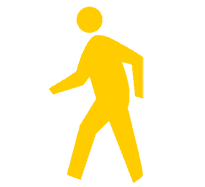 Pedestrian Ahead Warning Light
Pedestrian Ahead Warning Light
The Chevrolet Traverse pedestrian ahead warning light illuminates in amber when a pedestrian has been detected in front of the vehicle. As with the FCA system, Front Pedestrian Braking (FPB) helps to reduce the vehicle’s speed by mild deceleration. FPB alerts the driver via a red warning light and audible alerts.
Many of these system use the camera sensor located at the top-center of the windshield and radar sensors located on the vehicle’s front grille. Ensure all area are kept clean for optimal use.
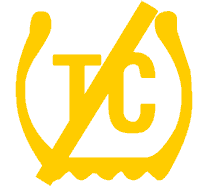 Traction Control Off Warning Light
Traction Control Off Warning Light
Traction control helps to prevent wheel slip and is always on by default. Turning off traction control can be beneficial if your vehicle is stuck in snow, mud etc, where wheel slip may be required to free your vehicle. If you’re experiencing faults, see traction control dashboard warning light.
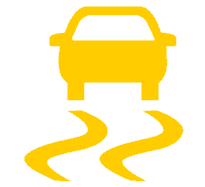 Electronic Stability Control Warning Light
Electronic Stability Control Warning Light
Electronic Stability Control (ESC), or ‘StabiliTrak’ as Chevrolet call it, is a system that helps to control understeer, oversteer and maintain traction. For further information, see how does ESC work in cars.
There’s two possible reasons why the ESC warning light comes on. If it flashes, it means the ESC system is working. If it remains constantly lit, it means there’s a fault with the system. The most common reason of a faulty ESC system is due to damaged wheel speed sensors.
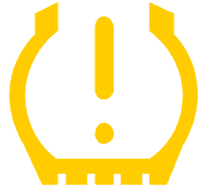 Tire Pressure Warning Light
Tire Pressure Warning Light
The tire pressure warning light comes on when any of the road tires deflates or loses substantial pressure. The Chevrolet Traverse is equipped with a tire pressure monitoring system (TPMS) which uses a sensor inside each of the four tires.
If there’s a problem with the TPMS, the warning light flashes initially for 60 seconds, then remains lit. Common reasons for the tire pressure light flashing is:
- Tires been fitted that are no in accordance with the manufacturer’s guidelines
- A damaged pressure sensor (usually during tire fitting)
- The spare tire is fitted
- The battery in one of the sensors is low
- Non-approved tire sealant is used
Tire Fill Alert
Your Chevy may be equipped with the tire fill alert system. The tire fill alert provides a visual and audible alert to signal when tires are filled to the recommended cold tire pressures. Cold tire pressures can be found on a sticker inside the driver’s door jamb. When the low tire pressure warning light comes on:
- Park the vehicle on a level surface.
- Firmly apply the parking brake.
- Shift the gear lever into P (Park).
- Add air to the tire that is underinflated.
- The turn signal light will now flash.
- When the recommended tire pressure is reached, the horn sounds once and the turn signal light will stop flashing and briefly turn solid.
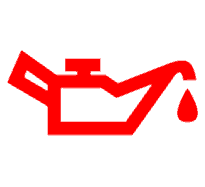 Oil Pressure Warning Light
Oil Pressure Warning Light
The red oil pressure light remaining lit is s symptom of low oil pressure. Low oil pressure means that engine components may not be properly lubricated, which can result in damage. If the oil light comes on while driving, stop and switch off the engine as soon as it’s safely possible.
Low oil levels can also trigger the oil pressure light. Check oil levels and add fluid if necessary. Only continue to drive the Chevy if the oil light goes off. Possible reasons may be due to a pressure sensor fault, oil pump fault.
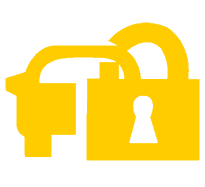 Security Warning Light
Security Warning Light
The Chevrolet Traverse security warning light should switch off once the engine has started. If it remains lit, it means there’s a fault with the immobilizer system. The RKE (Remote Keyless Entry) transmitter key must match with the Traverse’s immobilizer control unit. If the key does not start the vehicle, try a second if you have it. Try placing the key in the transmitter pocket in the center console to start the vehicle.
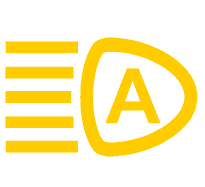 IntelliBeam Warning Light
IntelliBeam Warning Light
The Chevrolet Traverse intelliBeam system automatically turns on or off the vehicle’s high beam headlights based on the surrounding traffic conditions. This warning light illuminated when intelliBeam is enabled. The system uses the camera sensor located at the top centre of the windshield. For continues uninterrupted operation, ensure this area is kept clean.
